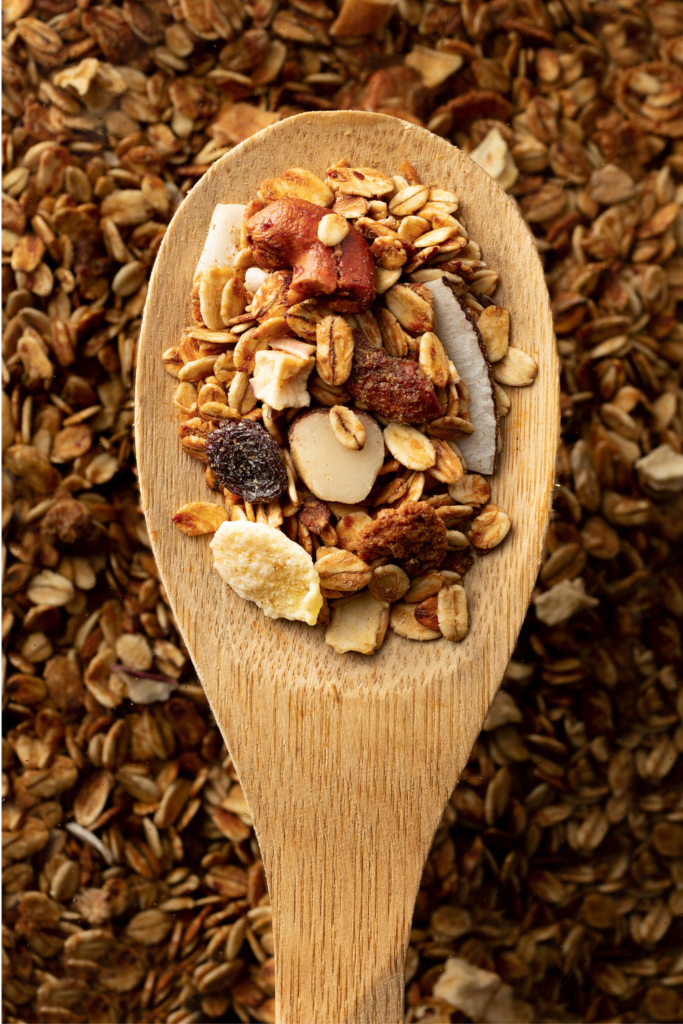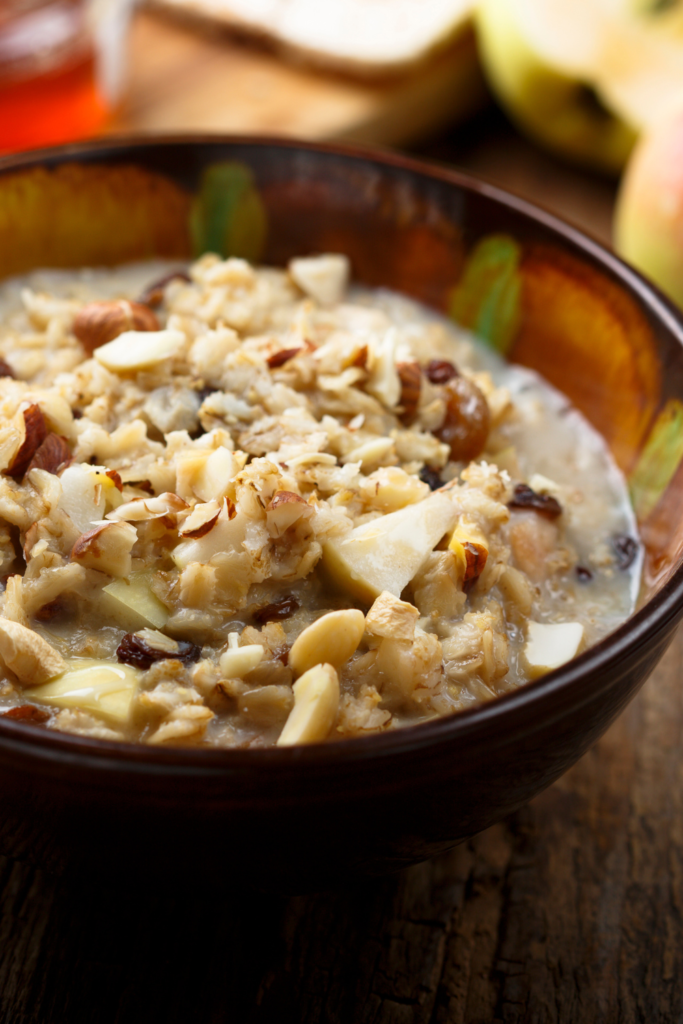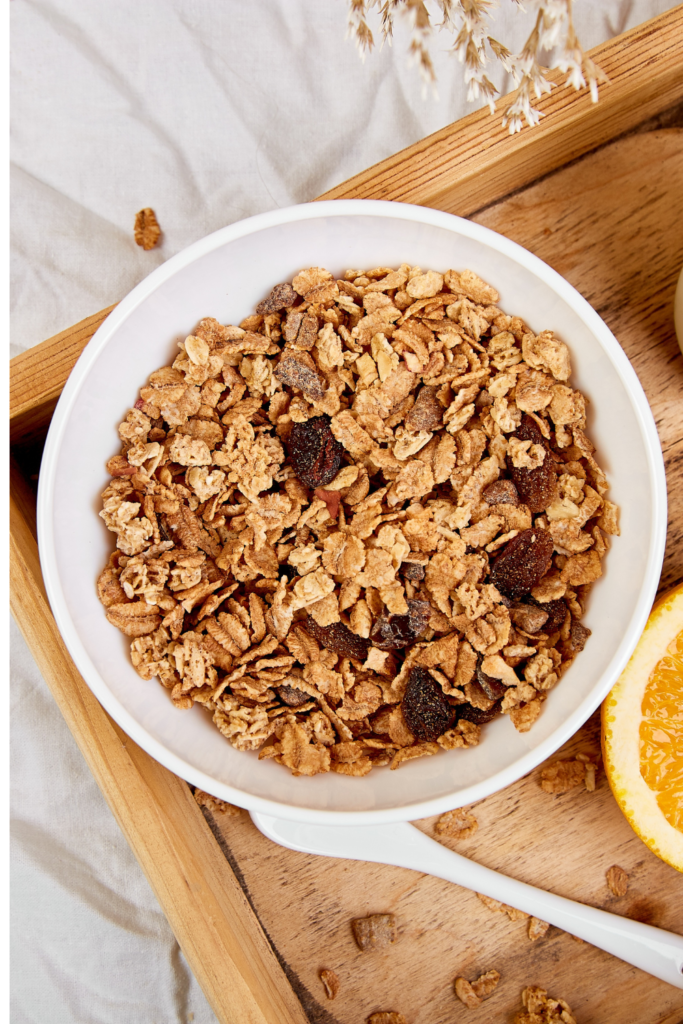
Discuss how muesli and granola can fit into a weight loss diet by focusing on typical serving sizes, lower calorie options like Bircher muesli, and the importance of portion control.

The management of blood sugar levels is a critical aspect of nutrition, especially for individuals concerned about or managing type 2 diabetes. Muesli and granola, popular breakfast options, can have varying impacts on blood sugar levels, primarily influenced by their glycemic index (GI) and fiber content.
Customizable Homemade Granola Recipe
Ingredients:
Instructions:
Cook’s Notes:
The glycemic index is a measure that ranks foods based on how quickly they raise blood sugar levels. Foods with a high GI are digested and absorbed more rapidly, causing a quicker and higher spike in blood sugar, while low GI foods have the opposite effect.

Granola, depending on its ingredients and preparation, can have a moderate to high glycemic index. This is often due to the addition of high-GI ingredients like honey, maple syrup, brown sugar, or chocolate chips. In contrast, traditional muesli, which is typically less processed and contains fewer added sugars, generally has a lower glycemic index.
Fiber plays a significant role in managing blood sugar levels. High-fiber foods slow down the digestion and absorption of carbohydrates, leading to a slower and more gradual rise in blood sugar. Both muesli and granola are typically rich in fiber, especially when they include ingredients like whole oats, nuts, seeds, and dried fruits. However, the actual fiber content can vary significantly between different brands and recipes.

For individuals concerned about blood sugar levels, choosing muesli and granola varieties with high fiber content and minimal added sugars is crucial. Opting for products that use whole grains and natural sweeteners in smaller amounts can help in maintaining a lower glycemic index.
For those at risk of or managing type 2 diabetes, it’s important to be mindful of the type and amount of muesli or granola consumed. A muesli or granola that is high in fiber, low in added sugars, and includes whole grains can be a suitable part of a diet aimed at controlling blood sugar levels.

In addition to choosing the right product, portion control is essential. Even a low-GI, high-fiber cereal can lead to increased blood sugar levels if consumed in large quantities. It’s recommended to adhere to typical serving sizes and, if needed, consult with a healthcare provider or dietitian to understand the appropriate portion size based on individual health goals and conditions.
In summary, both muesli and granola can be part of a diet that supports healthy blood sugar levels, but their impact largely depends on their composition and the quantity consumed. For the best health outcomes, particularly for individuals with or at risk of type 2 diabetes, choosing varieties with low glycemic indices, high fiber content, and minimal added sugars, along with practicing portion control, is advisable. These considerations help in leveraging the health benefits of these nutritious cereals while managing blood sugar levels effectively.
Provide tips on selecting muesli and granola varieties with fewer calories and lower sugar content for those focused on weight management.

Highlight how athletes can use muesli and granola as a source of sustained energy and protein content, especially when combined with additional nutritional supplements.
Explore the role of nutrient-dense mueslis and granolas in muscle recovery and building, especially when paired with protein-rich foods like Greek yogurt or peanut butter.
Discuss ways to introduce children to muesli and granola as a part of a healthy diet, focusing on kid-friendly recipes and the importance of establishing healthy eating habits early.
Offer recipes and ideas for making muesli and granola appealing to younger palates, such as adding natural sweeteners like apple juice or including fun ingredients like chocolate chips.
Delve into the sustainability aspect of muesli and granola, discussing how choosing products with minimal added sugars, organic ingredients, or locally sourced components can reduce environmental impact.

Encourage readers to support ethical brands and local producers who focus on sustainable practices in producing muesli and granola. This recipe is my favorite sweet.
Look ahead at emerging trends in the muesli and granola market, such as the use of exotic fruits, ancient grains, or superfood additions.
Consider how advancements in nutrition science and technology might influence the development of healthier, more nutritious muesli and granola varieties.
Conclude by emphasizing that both muesli and granola have their place in a balanced diet. Encourage embracing variety and trying both to enjoy their unique flavors and health benefits.
For athletes and fitness enthusiasts, the quest for the perfect energy-boosting and muscle-building meal is perpetual. Enter muesli and granola, two powerhouse breakfast options that can be pivotal in an athletic diet. Here’s why they are more than just your average cereal.
Both muesli and granola are predominantly made from whole grains, notably oats, which are an excellent source of complex carbohydrates. These complex carbs are key for athletes because they break down slowly in the body, providing a steady release of energy. This gradual energy release is crucial during long training sessions or competitions, where sustained energy levels are vital for peak performance.
Additionally, the fiber content in these cereals aids in slowing down digestion, further extending the energy release. This can help in maintaining endurance and preventing energy crashes, which are often caused by foods high in simple sugars.
Protein is an essential macronutrient for muscle repair and growth, making it a crucial part of any athlete’s diet. Muesli and granola can be excellent sources of protein, especially when they include nuts, seeds, and whole grains. For instance, almonds, pumpkin seeds, and chia seeds not only add a crunchy texture but also significantly boost the protein content.
When combined with milk, yogurt, or a protein-rich plant-based alternative like soy or almond milk, the protein content of a muesli or granola meal increases substantially. This makes for a well-rounded meal that supports muscle recovery and growth, especially post-workout.
One of the greatest strengths of muesli and granola is their versatility. Athletes can customize them to fit their specific dietary needs. By adding protein powders, amino acids, or other nutritional supplements, they can transform a simple bowl of cereal into a high-performance athletic meal.
Protein powders, for example, can be easily mixed into muesli or granola, significantly increasing the protein content for muscle repair. For athletes focusing on endurance sports, adding supplements like branched-chain amino acids (BCAAs) can aid in muscle recovery and reduce fatigue.
Muesli and granola often contain nuts and seeds, which are not just sources of protein but also healthy fats. These fats, particularly omega-3 and omega-6 fatty acids, are essential for athletes as they support heart health, reduce inflammation, and improve joint mobility. Moreover, fats are a dense source of energy, crucial for those engaging in long-duration sports.
Lastly, the convenience factor of muesli and granola cannot be overstated. For athletes with busy training schedules, preparing a nutritious, energy-packed meal quickly is often a challenge. Muesli and granola can be prepared in minutes and are easily transportable, making them a practical option for athletes on the go.
In conclusion, muesli and granola are not just healthy breakfast options but can be integral components of an athlete’s diet. They offer sustained energy, are a good protein source, and can be customized with additional supplements to meet specific athletic needs. Whether it’s for muscle repair, energy sustenance, or simply a convenient meal option, incorporating muesli and granola into an athletic diet can significantly contribute to an athlete’s performance and overall health.
Reiterate the importance of breakfast in a healthy lifestyle, highlighting how muesli and granola can be integral parts of this journey. Encourage readers to continue exploring and enjoying these nutritious breakfast options. Here is my weakness recipe here.

In the journey towards a healthy lifestyle, breakfast stands as a fundamental pillar. Often hailed as ‘the most important meal of the day,’ it kickstarts your metabolism, fuels your body for the day ahead, and can set the tone for your dietary choices. Integrating nutrient-rich foods like muesli and granola into your morning routine can significantly contribute to this wellness voyage.
Starting your day with a nutritious breakfast has been linked to numerous health benefits. It revs up your metabolism, helping your body start burning calories from the morning. Additionally, a healthy breakfast stabilizes blood sugar levels, which controls appetite and energy levels throughout the day. This is particularly crucial for maintaining focus, whether at work or during physical activities.
Muesli and granola emerge as champions in the realm of healthy breakfast options. Both are typically packed with whole grains, such as oats, which provide a steady supply of complex carbohydrates – the body’s preferred energy source. The presence of fiber in these cereals aids in digestion and helps in prolonged satiety, reducing the urge for mid-morning snacking.
What makes muesli and granola particularly appealing is their versatility. They can be rich sources of vitamins, minerals, and other essential nutrients, especially when combined with nuts, seeds, dried fruits, and dairy or plant-based milk. This combination delivers a balanced meal of carbohydrates, proteins, healthy fats, and fiber.
For those on a weight management journey, muesli and granola can be excellent allies. They provide a nutrient-dense, fulfilling meal that satisfies hunger and helps prevent overeating. By choosing options with minimal added sugars and high fiber content, one can enjoy a delicious yet health-conscious breakfast.
The world of muesli and granola is vast and ripe for exploration. From store-bought varieties to homemade recipes, there’s a multitude of flavors and combinations to discover. Experiment with different ingredients like coconut flakes, cinnamon, pumpkin seeds, or fresh fruits to create your personalized breakfast bowl.
For a change of pace, muesli and granola aren’t limited to just bowls. Sprinkle them on yogurt, blend them into smoothies, or bake them into bars for a nutritious snack on the go. The possibilities are endless.
Incorporating muesli and granola into your breakfast routine is more than just about eating something in the morning. It’s about nourishing your body, delighting your taste buds, and making a conscious choice towards a healthier lifestyle. As you continue on your health journey, keep exploring the rich and diverse world of these nutritious breakfast options. They are more than just cereals; they are stepping stones to better health and well-being. Remember, a day that begins well tends to unfold well, and with muesli and granola, you’re starting on the right foot.
Invite readers to become part of a community focused on healthy living by sharing their experiences, recipes, and tips for incorporating muesli and granola into their daily routines.
Encourage readers to continue the conversation online, be it through social media, forums, or blog comments, fostering a supportive network of health-conscious individuals.